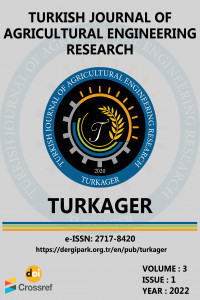Important Physical and Mechanical Properties of Dominant Potato Variety Widely Grown in Ethiopia
Important Physical and Mechanical Properties of Dominant Potato Variety Widely Grown in Ethiopia
physical, mechanichal, potato tuber, property, variety Attribute,
___
- Alemu DA, Fanta A and Getnet B (2021). Performance evaluation of engine operated potato grader; Ethiopian Journal of Agricultural Science, 31(2): 61-71.
- Almaiman S and Ahmad D (2002). Changes in physical and chemical properties during pomegranate (Punica granatum L.) fruit maturation. Journal of Food Chemistry, 76: 437-441.
- Amin MN, Hossain MA and Roy C (2004). Effects of moisture content on some physical properties of lentil seeds. Journal of Food Engineering, 65: 83-87.
- Asoegwu SN (1995). Some physical properties and cracking energy of conophor nuts at different moisture content. International Agrophysics, 9(2): 131-142.
- Ayalew T (2014). Potato seed systems in Ethiopia. Asian Journal of Agricultural Research, 8(3): 122-135.
- Central Statistical Agency (CSA) 2009. Agricultural sample survey Report on area and production of crops, Addis Ababa, (p. 126), Ethiopia.
- Central Statistical Agency (CSA) 2015. Report on area and production of major crops (Vol. I). Addis Ababa, Ethiopia.
- Food and Agricultural Organization (FAO) (2009). Sustainable potato production-Guidelines for Developing Countries. Agricultural and Forest Meteorology (Vol. 127). https://doi.org/10.1016/j.agrformet.2004.08.003.
- Gebru H, Mohammed A, Dechassa N and Belew D (2017). Assessment of production practices of smallholder potato (Solanum tuberosum L.) farmers in Wolaita zone, Southern Ethiopia. Journal of Agricultural and Food Security, 6 (31): 1-11.
- Hurst WC, Reynolds AE, Schuler GA and Christian JA (1993). Maintaining Food Quantity in Storage. University Of Georgia Cooperative Extension Service Bulletin 914.
- Joshi AV and Raisoni GH (2016). Review Paper on Physical and Mechanical Properties of Citrus Fruits and Various Techniques used in Fruit Grading system based on their sizes. International Journal of Science Technology & Engineering, 3(4): 129-132.
- Kamat V, Sisodiya JH, Mahawar MK and Jalgaonkar K (2020). Determination of some physical properties of Plum (cv. Kala Amritsari) fruits. International Journal of Chemical Studies, 8(3): 225-228.
- Malcolm EW, Tappan JH and Sister FE (1986). The size and shape of typical sweet potatoes. Transactions of the ASAE, 29: 678-682.
- Mohsenin NN (1986). Physical properties of plant and animal materials. Department of Agricultural Engineering, Pennsylvania State University, Gordon & Breach Science Publishers, New York.
- Puchalski C, Brusewitz G and Slipek Z (2003). Coefficients of friction for apple on various surfaces as affected by velocity. Agricultural Engineering International: the CIGR Journal of Scientific Research and Development”. Manuscript FP 03 002. Vol. V. December 2003.
- Rahman MS (2014). Engineering properties of foods, 4th Edition. Newyork: CRC Press Taylor & Francis Group. https://doi.org/International Standard Book Number-13: 978-1-4665-5643-0 (eBook - PDF). Boca Ratan, London,
- Razavi SMA, Emadzadeh B, Rafe A and Mohammad Amini A (2007). The physical properties of pistachio nut and its kernel as a function of moisture content and variety: Part I. Geometrical properties. Journal of Food Engineering, 81: 209-217.
- Yayın Aralığı: Yılda 2 Sayı
- Başlangıç: 2020
- Yayıncı: Ebubekir ALTUNTAŞ
Multipurpose Fruit Juice Machine for Preventing Fruit Wastage in Nigeria Villages
Evaluating the Effects of Milling Speed and Screen Size on Power Consumed During Milling Operation
Ademola ADENIGBA, Samuel Dare OLUWAGBAYIDE
Ide PATRICK EJIKE, Ikoko OMENAOGOR
Effects of Different Carbonization Conditions on the Color Change of Biochar
Alperay ALTIKAT, Mehmet Hakkı ALMA
Nimet KATAR, Mustafa CAN, Duran KATAR
Hilary UGURU, Ovie AKPOKODJE, Goodnews Goodman AGBI
Adewale SEDARA, Emmanuel ODEDİRAN
Optimization of Mechanical Oil Expression from Sandbox (Hura crepitans Linn.) Seeds
David ONWE, Adeleke Isaac BAMGBOYE
Mathematical Modelling of Drying Characteristics of Coconut Slices
John ISA, Kabiru Ayobami JİMOH
Important Physical and Mechanical Properties of Dominant Potato Variety Widely Grown in Ethiopia
